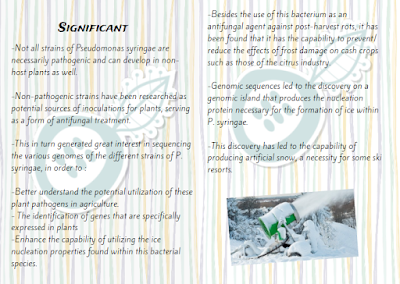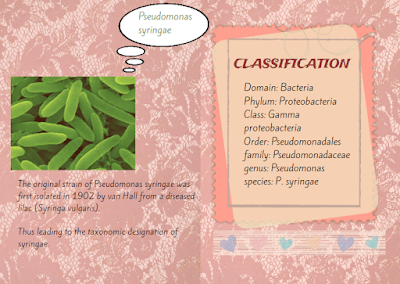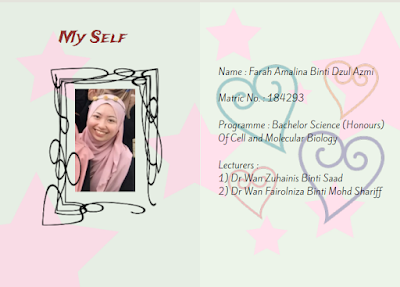On 15th Feb at DKU, Dr Wan gave us a briefing about Adopt a Microbe project. This is an individual task and each of us must did a digital scrapbook and present a 3 Minute Talk. We need to choose the microbe at interest. I need almost 3 days to choose which microbe that I'm going to adopt because there were so many choices. Everyday I keep change my microbe and at last I choose Pseudomonas syringae as my Adopt A Microbe. Then, we need to retrieve and gather information about the microbe from articles, scientific journals, books and other wide variety of reliable resources. I choose cliptomize website to do my digital scrapbook. I took almost a week to finish up my digital scrapbook, Eventhough, I had a tough week during doing this digital scrapbook, I manage to settle it on time before the submission date opened.
After did some research about Pseudomonas syringae, i had found many information about it.For two and a half years workers have been preparing the mountains of Vancouver to host the 2010 Winter Olympic Games. But they haven’t been the only ones hard at work. You may be surprised to learn that the bacteria, Pseudomonas syringe, are responsible for the production of artificial snow. For twenty years ski resorts and other winter attractions have been using artificial snow to create the perfect slopes and scenery. If the Olympic competitors need a little more snow under their skis, it is likely that Pseudomonas syringe will come to the rescue.
With the advent of climate change and increased tourism in snowy areas, ski resorts and winter wonderlands were facing a major problem. During light winters, and at the beginning or ends of the snowy season, there wasn’t enough snow coverage for the amount of people flooding the mountain sides. Luckily, a discovery by microbiologists at the University of Wisconsin, Madison would solve the snow crisis. While studying disease in plants they found a specific strain of bacteria,
Pseudomonas syringe, were responsible for initializing ice crystallization in water. These properties could be harvested and used to make snow.
It all starts with the bacteria’s outer membrane. Pseudomonas syringe has a special protein located in the outer membrane called an Ice Nucleating Protein. Under favorable environmental conditions the INP changes configuration to form a “nucleation site”. It is speculated that when water enters the nucleation site it becomes crystallized. The small, newly formed crystal then acts as a seed and locks other water molecules around it into an ice structure. However, the exact mechanism used by the bacteria remains unknown. Ice crystals naturally form in the sky around -7°C and fall to the ground as snow. Pseudomonas syringe can naturally nucleate ice crystals at -2°C on land or in the sky, making snow easier to produce.
Pseudomonas syringe has other unique properties in addition to their snow making ability. This gram negative, rod shaped organism is psychrotrophic and can withstand temperatures below 7°C. They are strictly aerobic and fluorescent bacteria. Surprisingly, it is also a very common microbe. While it typically associates with plants at densities of up to 1014 cells per hectare of agricultural land, it can also be found in water and in snow. In water they reach a concentration of 100 to 1000 bacteria per liter and in snow they reach up to 105 bacteria per liter. With such a natural abundance in cold climates, these microbes are a perfect addition to the 2010 Winter Olympic Games.
Despite the thrill of artificial snow, there have been some skeptics that believe the microbes can cause harm. While some strains of bacteria have caused disease and sickness in humans, Pseudomonas syringe is not one of them. Extensive research has shown that exposure to the bacteria has no effect on skiers or workers. Moreover, the bacteria are rendered inactive before they are used on the mountain sides. Because the INP protein is on the outer membrane and can readily react with water there is no need for the cells to remain functional. This increases the safety factor for those who come into contact with the organism. Fans and officials can be certain that the snow on the Vancouver mountainsides will not be a danger to any of the Olympic athletes.
Whether it is cross-country skiing or freestyle snowboarding the Winter Olympics would not be the same without the help of Pseudomonas syringe. Next time you visit the slopes keep these microbes in mind. They work hard so we can have fun.
 |
| My 3mt slide |
On the 3nd June 2016, which is on Friday, I had presented my adopted microbe at DKU. I did admit that I get nervous and break out in a cold sweat, but Alhamdulillah everything went fine. Thanks to Dr Wan and Dr Fairol for the amazing experience and also for everything. I really fall in love with microbiology because of them.


















































